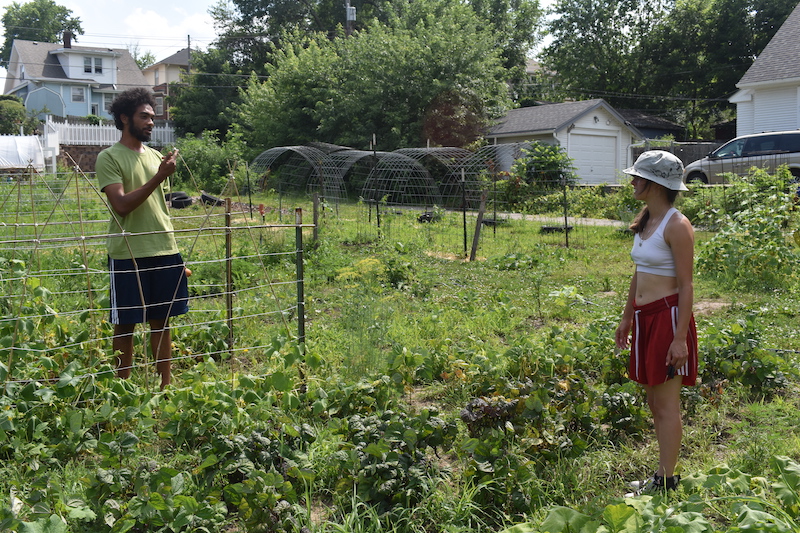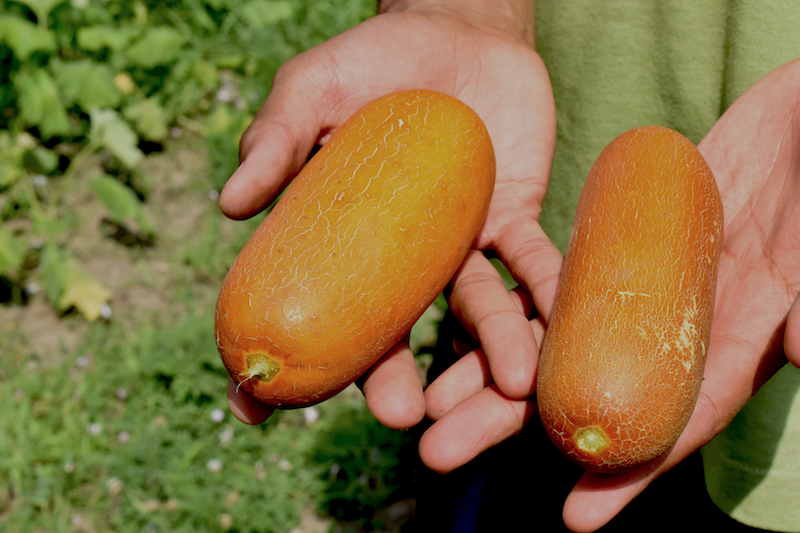
Decker Woods and Sophia Cooper exchange farming tips in Big Muddy Farms’ biggest plot, July 6, 2021 (Photo by Jules Struck).

Decker Woods and Sophia Cooper exchange farming tips in Big Muddy Farms’ biggest plot, July 6, 2021 (Photo by Jules Struck).
OMAHA, Nebraska — Decker Woods was elbow-deep in a bin full of kale. He was boxing up an order for a local juicery, one of a few business deals he set up as a new urban farmer. He only got into the trade nine months ago, and is also a rapper and video editor — all work that makes up his income.
“It’s really healing to be able to tend to a space where food comes from,” said Woods, shoveling fistfuls of leafy greens into bins. “You put love in and you get love out.”
Woods is 24 years old and is part of a nonprofit urban farming program in Omaha, Nebraska called Big Muddy Urban Farm, which houses burgeoning young farmers rent-free, hands them $10,000 and a few urban plots, and guides them to build a business plan to pay back the loan. Then, they get to growing.
“It’s like a simulation of a business,” Woods said. The aspiring farmers get to hop in for a year with a financial safety net from years before if profits don’t cover costs.
The program minimizes some of the financial barriers that keep potential farmers from entering the industry, like low profit. Many farmers have a working partner to make up a living income every year or a second job, like Woods, who raps and produces freelance videos.
For producers, small-scale urban operations also avoid the financial challenges of buying swaths of expensive cropland. These farmers can’t grow enough food to fill huge orders, so they’re dependent on small and individual buyers.
About 50 to 60 customers buy from Big Muddy’s Community Supported Agriculture. Avenues to fresh produce are needed in the Omaha-Council Bluffs metro area, where 9% of people live in a food desert, according to The Landscape, a data collection project of the Omaha Community Foundation.
Nationally, 4% of people live in a food desert, an area where at least 1 in 3 live at least a mile from a grocery store and 1 in 5 people live below the poverty line.
Wide Lens A third of the globe lives in urban areas, according to a 2020 report from UN Habitat, which predicts that share will grow to 39% by 2035. At the same time, global demand for food will increase 70% by 2050, predicts the World Bank.
Money is a concern for producers, too. The farmers in Big Muddy’s program, like many young farmers, pick up odd jobs to keep their budget sheets in the black. The USDA census reports that 65% of young farmers have a primary occupation other than farming.
With enough land, “I can grow as much food as I want, but if there’s nobody to buy it then I’m not going to make any money,” Woods said.

A ‘big safety net’
When Sophia Cooper was a kid, she would catch fish in her hands in the trash-filled creek by her house in Council Bluffs, Iowa. As a 20-year-old, she talked about that love of kicking around outside all day, and channeled that into her own farming and volunteer work, introducing kids in Omaha to gardening and growing food.
“We always think kids aren’t paying attention, but they’re so good outside,” she said. “They’ll dig in the soil, they don’t care if they’re dirty. They have no cares.”
Cooper is another resident at Big Muddy, and a senior at University of Nebraska Omaha, where she studies secondary education. She said she has options for what to do in the future, like teaching, wool farming, or cannabis farming, but she has to factor-in how to make a living.
The initial costs of starting a farm are daunting. “Farmland typically stays within families for years and years, and then it’s expensive,” she said. “If you don’t have access to income already, then you’re just not going to get it. You’re just never going to be able to buy it.”
Only 4% of farmland was expected to be sold from 2014 to19, according to a USDA report, with 38% of those sales between relatives.
Wide Lens Lending to smallholder farmers is difficult, according to The World Bank, which estimated in 2014 that their lending avenues were reaching less than 10 percent of smallholders.
Cooper says free rent and land from Big Muddy are a big help, but she still works tutoring and waitressing gigs on the side.
Woods said he knows people who are interested in starting their own farms, but it’s just too expensive for them to get started. For him, it’s a “big safety net” to not have to pay for rent and land, he said.
He could make the move to farming because “I didn’t put any risk into it,” he said.
Representation matters
Woods had been interested in sustainable agriculture before he ever considered farming in Nebraska, but didn’t see people of color represented in his community until he took an online class run by Ron Finley, a Black urban farmer and fashion designer.
“I was like, ‘oh, Black people can grow food,’” Woods said.
Black farmers in America have historically faced significant social and economic barriers to owning and operating their own land. After Emancipation, the U.S. government failed to implement a land settlement plan, leaving many former slaves with no economically viable option for buying land, according to a USDA report.
The decades following saw mixed progress for Black farmers. Land ownership increased, but most Black farmers faced “economic stagnation” fueled by racist Jim Crow laws, according to the report. And while the New Deal of the 1930s shored up subsidies for white farmers, Black farm ownership decreased from lack of access to those programs.
Today, only 5% of American farmers are people of color, according to the USDA census, though their numbers grew 7.5% from 2012 to 2017.
Young, diverse farmers need to see their peers in the farming community, Woods said. Until Finley’s class, he couldn’t see farming in his future. Woods said, “I always thought agriculture was important, I just never could see myself being the person to do it.”
Cooper wound her way under the beaming July sun through Omaha’s Gifford Park neighborhood, where Big Muddy’s plots are scattered like neat, leafy vistas. She skirted behind a house to arrive at one of the farm’s chicken coops.
“It’s very hard to find a space,” she said, surveying the chickens. “Being a woman, being a woman of color, like, where do I get accepted in this field?”
Back at the house, Woods finished packing up his kale for Susan Safia. She’s the founder of Life Elixir Juice and a young, Black woman. They packed the greens into Safia’s car and haggled congenially for a moment over the price.
“The things that I can find locally, I really want to support because it helps my business,” she said. “I can say that this produce came locally.”
Woods said he sees more and more people interested in where their food comes from. “I think people are just getting tired of living (a) life where they don’t actually get to connect with the earth,” he said.
Across the street, the rows of cucumbers, melons, and squash that Woods tends ate up the summer sun.
“You know, there’s something good even in just having your own backyard vegetable garden,” he said. Sustainable, regenerative farming — “it’s the only right way to farm.”
—
About this series: The Planet Forward-FAO Summer Storytelling Fellows work was sponsored by the North America office of the Food and Agriculture Organization of the United Nations (FAO), and the Fellows were mentored by Lisa Palmer, GW’s National Geographic Professor of Science Communication and author of “Hot, Hungry Planet.”